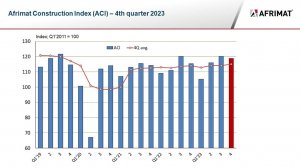Afrimat Construction Index reflects 3% y/y growth in the fourth quarter
The “lethargy” of the South African economy as a whole during the fourth quarter of 2023 was evident in the construction sector, with five of the ten constituent indicators of the Afrimat Construction Index (ACI) recording quarter-on-quarter negative real growth rates.
As a result, the ACI worsened by 1.2% quarter-on-quarter.
“However, viewed year-on-year, the ACI expanded and even outperformed the economy with a 3% real growth rate, compared to real gross domestic growth of 1.2%. The year-on-year growth rate was mainly due to exceptionally strong performances by the indicators for employment and wholesale sales of construction materials,” economist Dr Roelof Botha points out.
Botha, who compiles the index on behalf of mining and materials company Afrimat, says the year-on-year expansion of the ACI is encouraging, especially against the background of the high cost of capital in South Africa.
He adds that it was especially encouraging that the important indicator of job creation expanded in 2023, with 110 000 new jobs having been created, compared with 31 000 in 2022.
The index recorded a level of 118.9 in the fourth quarter, compared with 120.3 in the third quarter, and 116 in the second quarter.
“Significantly, the latest four-quarter average reading of the ACI – which eliminates seasonal influences – has risen further and is close to the same level as before Covid-19, which means that construction activity has more or less fully recovered from the negative impact of the lockdowns and recession that accompanied the pandemic.”
Botha avers that the index values for the fourth quarter are not strictly comparable to the previous quarter owing to the broadening of the base of constituent indicators to include the real value of construction works, a component of gross fixed capital formation in the economy.
“Also encouraging is the quarter-on-quarter increase of 9% in the value of new buildings completed, albeit from a low base. It remains concerning, however, that the real value of construction works remains lower than in the fourth quarter of 2019 – pre-Covid-19. This indicator is under pressure from a combination of fiscal constraints, dysfunctional municipalities and restrictive monetary policy,” he says.
According to Botha, the two indicators in the ACI that continue to fare very poorly are the value of building plans passed and buildings completed at larger municipalities.
He explains that these data sets are aligned with the continued decline in the number of mortgage bond applications administered by BetterBond and a considerable increase in the average deposit required for a home loan.
In 2019, first-time homeowners required a deposit of about R60 000, on average, to access a mortgage loan. “This has now shot up to just below R250 000, which acts as a significant deterrent to residential property market activity,” Botha warns.
Meanwhile, he points out that several key drivers have come to the fore that may lead to an expansion of construction activity this year and beyond.
These include further progress with the switch to renewable energy, much of which is intrinsically linked to construction activity; visible signs of closer cooperation between the private sector and government agencies in the maintenance, repair and expansion of the country’s logistics infrastructure; and the consistent decline in the consumer price index and producer price index, which should lead to a series of interest rate declines in the year.
Several economists polled by Unisa’s Bureau for Market Research expect interest rates to decline by up to 100 basis points this year and even further in 2025.
Comments
Press Office
Announcements
What's On
Subscribe to improve your user experience...
Option 1 (equivalent of R125 a month):
Receive a weekly copy of Creamer Media's Engineering News & Mining Weekly magazine
(print copy for those in South Africa and e-magazine for those outside of South Africa)
Receive daily email newsletters
Access to full search results
Access archive of magazine back copies
Access to Projects in Progress
Access to ONE Research Report of your choice in PDF format
Option 2 (equivalent of R375 a month):
All benefits from Option 1
PLUS
Access to Creamer Media's Research Channel Africa for ALL Research Reports, in PDF format, on various industrial and mining sectors
including Electricity; Water; Energy Transition; Hydrogen; Roads, Rail and Ports; Coal; Gold; Platinum; Battery Metals; etc.
Already a subscriber?
Forgotten your password?
Receive weekly copy of Creamer Media's Engineering News & Mining Weekly magazine (print copy for those in South Africa and e-magazine for those outside of South Africa)
➕
Recieve daily email newsletters
➕
Access to full search results
➕
Access archive of magazine back copies
➕
Access to Projects in Progress
➕
Access to ONE Research Report of your choice in PDF format
RESEARCH CHANNEL AFRICA
R4500 (equivalent of R375 a month)
SUBSCRIBEAll benefits from Option 1
➕
Access to Creamer Media's Research Channel Africa for ALL Research Reports on various industrial and mining sectors, in PDF format, including on:
Electricity
➕
Water
➕
Energy Transition
➕
Hydrogen
➕
Roads, Rail and Ports
➕
Coal
➕
Gold
➕
Platinum
➕
Battery Metals
➕
etc.
Receive all benefits from Option 1 or Option 2 delivered to numerous people at your company
➕
Multiple User names and Passwords for simultaneous log-ins
➕
Intranet integration access to all in your organisation





















